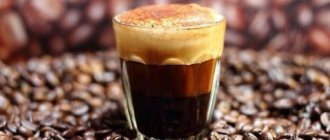Cappuccino only seems like a simple mixture of espresso and milk. The cooking process, the quality of the ingredients, and even the utensils are important. Every lover of the Italian drink can make cappuccino in a coffee machine. But to make it as tasty as in coffee shops, you need to know all the nuances of this process and take into account even the most insignificant details.
Types of cappuccino makers for making cappuccino
On the modern market, devices for preparing frothed milk are represented by three main segments:
- Automatic . This is an attachment for a coffee machine, which includes a tube directed into a container with milk, and an outlet for the already steamed liquid, under which a mug is placed. The action occurs without human control, which simplifies the cooking process. Among the disadvantages : after each session it is necessary to disassemble and wash all components.
- Manual . The frother is part of the coffee machine. This is a metal tube that is pulled aside and immersed in a container of milk, foaming it. After each use, to ensure proper operation, wipe with a damp, clean cloth to avoid milky deposits.
- Mechanical . Devices that are completely separate from the coffee station are widely used at home. It is based on a metal spiral, twisted into a ring, to which rotation is applied. Distributed in two forms. The first is a metal glass with a cup holder connected to electricity. Depending on the price category, models have the function of either frothing cold milk or adding liquid heating. The average cost at the end of 2020 of such units is from 2.5 thousand rubles.
The second type is a manual milk frother , consisting of a volumetric handle that includes batteries and a mode switch, and a tube extending from it with a spiral end. It is immersed in hot milk and creates a thick foam. The most budget option for beginner baristas can be found at a price of less than a hundred rubles.
Related material: How to brew espresso in a Turk
Choosing milk for froth
A distinctive feature of cappuccino is the whipped milk foam, which is called “foam”. In order for it to turn out tender, aromatic and stable, you need to know how and how much to froth milk for cappuccino, and also be able to do it.
A very important step in preparing cappuccino with perfect foam is choosing high-quality milk that is ideal for this purpose.
Important! Low quality milk, incorrect temperature of the dairy product, low fat content - all these little things can completely ruin your favorite drink, killing the taste and airiness of the foam.
To ensure that the foam is tasty, thick and airy, choose milk that meets the following important criteria:
- protein content ranging from 2.8 to 3.8%;
- temperature – from +3 to +4 degrees;
- fat content – from 3.5%;
- the product must be pasteurized.
If you choose the wrong milk, the foam may simply not froth.
How to make cappuccino using a cappuccino maker in a coffee machine?
You should turn on the device in advance, wait about 10 minutes , then start working. The device needs to warm up. The ground coffee is poured into a special compartment along with seasonings. Further preparation steps depend on the type of foaming agent (automatic or manual).
If you are dealing with an automatic one, then all you need to do is place the container under the spill. A thick-walled cup with a volume of 180 ml is selected for the drink . Some models of coffee machines are equipped with heated containers; if the function is missing, heat the cup in hot water, then wipe it dry.
With a manual cappuccino maker, milk is poured into the pitcher. Steam begins to form after turning on the program, the first seconds of operation are idle, you need to wait for a dense hot stream of steam. Then the device is lowered into the thickness of the milk at an angle of about 45 degrees, 1.5 cm deep. When foam forms abundantly, the pitcher moves until all the liquid increases in volume.
The foamed milk is tapped on the table so that the foam settles and is distributed evenly. Pour a pre-prepared portion of espresso, if the foam does not drain, place it on top with a spoon.
Related material: Rules for diluting milk powder in coffee
Are there any differences in cappuccino foam and latte foam?
To understand the difference between latte and cappuccino foam, it is worth understanding the intricacies of its composition and preparation. In both cases, high quality milk is used for production, but the difference lies precisely in the ratio:
- for cappuccino – 1/3 foam and 1/3 milk. The foam turns out to be very large, it will not withstand powder, cocoa and granulated sugar;
- for latte – 1/5 foam and 3/5 milk. A characteristic feature of foam is its increased density. It easily holds powder, sugar and liquid chocolate on the surface, with which the barista can draw a real masterpiece and almost any image. To achieve such density, you need to choose the right milk of good quality and whip it, adhering to certain rules.
Cappuccino maker from Ikea
This device is in the mechanical category, budget-friendly and easy to use. To prepare the drink, take fat milk, from 3% or more ; it will add thickness and natural sweetness, the foam will last longer.
Heat the milk within 55–65 °C. Milk is poured into the container, the Ikea frother is turned on, and the rotating whisk is moved through different levels of liquid. When stable foam appears on the top one, they switch to the bottom one, until all layers of foam replace each other.
The prepared liquid is carefully poured into a pre-prepared cup of coffee so that the milk “cap” remains intact and is located on top. You can decorate the drink using stencils through which cinnamon spills out.
Fixed price cappuccino maker
Temperature and drink delivery
It’s not enough to prepare a delicious cappuccino in a coffee machine, you need to serve it correctly. You should drink the drink slowly, straight with foam. For serving, use heated thick-walled cups with a volume of 210 ml, made of ceramics or glass. The classic serving option involves the use of special containers called tazza. They are shaped like a bowl with a handle.
The ideal temperature for this drink is considered to be between 60–65 degrees, which allows you to feel all the notes of taste.
It is unacceptable to serve cappuccino whose temperature exceeds 70 degrees. Fresh pastries are considered the best addition to it.
The coffee machine can prepare a variety of drinks. Cappuccino is no exception. To obtain a delicate taste, you just need to take into account a few important points. By following the rules and preparation techniques, you will be able to enjoy an exquisite drink that is not inferior to the one prepared by professionals in coffee shops.
Ingredients for cappuccino
This is the simplest of coffee cocktails. Coffee base and heated foamed milk, placed in a “hat” on top. You can diversify the taste by decorating your coffee with cinnamon or grated chocolate, adding sugar or syrup.
What coffee is suitable for making cappuccino?
To make a cappuccino that will be remembered for a long time, the barista should use the right mixture of beans. Usually there is a mix of predominantly Arabica with the addition of Robusta. The grains are ground before cooking. If you suspect that they are musty, it is recommended to immerse them in ice water for 10 minutes , then heat them in the oven. They will begin to emit aroma again.
cappuccino using a cappuccino maker
An experienced barista advises taking Brazil and Ethiopia varieties; they are the most common among the quality ones. Further selection is based on taste preferences. Depending on the degree of roasting, sour-bitter coffee is selected; The average person is familiar with the tart, bitter taste, so dark roasted grain is used.
Ideally, ground coffee is used. If you use instant (granulated or freeze-dried) for preparation, then the quality of the aroma, essential oils and the percentage of caffeine will remain far from the first option.
How to pour foam into coffee correctly?
It remains to deal with the last nuance and understand how to pour foam into a cappuccino so as not to spoil the appearance and maintain its airiness. Follow one of the selected options:
- The milk can be slowly poured into the cup, holding the foam with a spoon. Next, pour in the coffee, and lastly place the foam on top;
- At the same time, add hot milk with foam to the cup, then pour coffee down the side in a thin stream;
- If you add sugar or alcohol to cappuccino, do it before adding milk and foam.
The last and most important point. Before creating your favorite drink, warm the cup by pouring boiling water over it from the inside. Otherwise, the foam will partially dissolve and lose density.
Characteristics of a cappuccino coffee machine
- The presence of a steam outlet tube or pannarello. This is a simple metal tube, not equipped with anything, or with a special nozzle that ends flattened (for greater foam formation) and has a small hole for air suction;
- Automatic cappuccino maker. Coffee machines of this type can be: A) With 2 boilers ; reduces waiting time after steam generation. That is, if there is a need to prepare cappuccino “on stream”, then you do not have to stop the process for the machine to cool down; B) with 2 pumps ; for simultaneous brewing of espresso and frothing milk foam B) full automation means that the cup does not have to be rearranged. Such models make more of a latte macchiato. A properly executed cappuccino requires first brewing the coffee base, then adding steamed milk. You can make the right cappuccino by pressing two programs “espresso” and “milk foam”.
- Capsule devices, where the milk part is represented by a dry concentrate.
How to prepare milk?
It is recommended to prepare the product before use.
What to do with the ingredient before whipping:
- Choose the freshest possible product, make sure there are no signs of souring.
- Store in the refrigerator at 2-6°C before cooking.
- To make the coffee warm, the milk should be heated. To do this, put the finished foam in the microwave or initially heat the ingredient to 65-70 °C. Do not allow overheating and boiling, otherwise you will not be able to make foam.
Which coffee machine is suitable?
Saeco Lirika One Touch Cappuccino
Saeco Lirika One Touch Cappuccino has a large water tank and a corresponding compartment for beans, 2 programs for milk drinks and coffee, and a ceramic coffee grinder. The user may not like the noisy operation of grinding grains. With small volumes of use, the poured water may become rotten, the grains may lose their aroma ( 31-48 thousand rubles for 2020 ).
Bosch TIS 30129 RW VeroCup 100
Bosch TIS 30129 RW VeroCup 100 is capable of brewing a coffee drink with 5 different strengths, partially warms the cup, reveals the aroma and taste of the beans due to direct grinding before preparation, and can simultaneously pour into 2 cups . This is not to say that making cappuccino with this cappuccino maker is a pleasure - the frother should be wiped after each use ( 22 thousand rubles ).
Delonghi ECAM 22.360
Delonghi ECAM 22.360. The model has a number of advantages: changes in the amount of foam are available, partial heating of the glass, double espresso once, high-quality production, 5-year . The downside is the lack of custom settings ( 38-55 thousand rubles ).
How to choose a coffee maker to make cappuccino
A drip coffee maker is an inexpensive piece of equipment that will quickly prepare your drink. Thanks to the spiral that heats the water, coffee preparation becomes possible. To start preparing cappuccino, pour water and pour coffee that has already been ground into a certain filter. After turning on the coffee maker, water will drip onto the coffee and then flow into the lower container.
Don't think that this coffee maker, although it has a lot of power, is strong enough. It's the other way around. Due to the rapid process, coffee does not have time to acquire the necessary aroma and taste of the beans. Two options can be proposed to solve this problem.
First, buy a coffee maker that has minimal power. In this case, the drink will be more aromatic and tasty. The second option is to buy a coffee maker in which you can adjust the power. Such devices are more expensive, but in this case, you will one hundred percent feel the peculiarity of the drink you consume.
But still, the drink you get at the end will not be one hundred percent reminiscent of real espresso. After all, the cooking technology is incorrect.
In most cases, carob coffee makers are used to brew the base of the drink. Also, they are also called espresso coffee makers. Making coffee does not take much time and occurs under fairly high pressure. No filters are used here. Instead, there are horns that are made of metal or plastic materials.
Cappuccino recipes
to diversify a coffee cocktail, the basis of which is only 2 ingredients . Over time, various preparation options have been created to help you understand how to make cappuccino.
Recipe 1
The simplest cappuccino using a whisk requires minimal spending. Suitable for people who are far from coffee culture and would like to get to know what cappuccino is. To prepare, you will need instant coffee and full-fat milk.
Bring water to a boil, pour in 1-2 teaspoons of coffee, add sugar if you want to soften the bitterness. Heat the milk until bubbles form, quickly remove before the boiling process begins. Then beat the hot milk with a whisk until a thick, foamy consistency forms. Cover with a milk cap of coffee. The cappuccino is ready.
Cappuccino recipes
Recipe 2
An option on how to make a decaffeinated vegan cappuccino using a cappuccino maker.
Choose decaffeinated ground or bean coffee and a richer plant drink (for example, coconut Aroy-D or NeMoloko 3,2%).
The following steps depend on the type of coffee machine: pour in the espresso base, pour in the milk analogue. Either one cappuccino program is launched, or two consecutive ones - espresso and milk foam. The prepared cappuccino is sweetened or decorated with cinnamon to taste.
Recipe 3
A one-minute recipe for those who want to achieve voluminous foam, has a mechanical cappuccino maker and is limited in time. Prepare instant coffee and sugar in equal parts, water and milk in double parts. Place everything except the last ingredient in an elongated container, dissolve, then whisk using a cappuccino maker. Add heated milk and beat again.
Recipe 4
A method for those who prefer to make cappuccino using a cappuccino maker or other frothing mechanism from ground coffee.
Cold water is filled into the Turk and 1-2 tablespoons of coffee . The mixture is brought to a boil, then removed from the heat, carefully poured to separate the sediment from the liquid. Separately, the milk is whipped with a whisk, mixer or mechanical cappuccino maker. Then it is added on top of the coffee.
Requirements for an ideal coffee foam
Let us remind you: cappuccino is espresso with heated and frothed milk. The ideal cappuccino contains equal parts espresso, milk and milk foam. Foam gives the drink tenderness, sweetness, and also acts as an insulator, maintaining the temperature and aroma of the coffee. The taste and other qualities of the drink depend equally on both components, and if the characteristics of coffee are largely set by the manufacturer, then preparing and frothing milk requires skill.
Milk froth for cappuccino is prepared correctly if:
- When transferred to a cup, it remains on the spoon or slowly drains from it. This indicates a dense and homogeneous consistency.
- There are no large bubbles in it. The air bubbles should be very small, this will provide density to the foam.
- It has a pleasant, slightly sweet taste with a creamy aftertaste. Properly prepared cappuccino is drunk without sugar, since when heated, the milk acquires a natural sweetness.
Cappuccino is distinguished by the presence of dense milk foam
Light and airy, but at the same time dense and thick, with a sweetish creamy taste - this is the ideal foam that will complement and highlight the bitterness and sourness of espresso.
Milk fat content
When choosing milk, you should pay attention to two indicators: fat content and protein content. The best option is pasteurized milk with 3.5% fat content, 2.5% is also suitable. With a reduced fat content (for example, 1–2%), the foam will be fragile. Some people prefer to use skim milk: it provides fewer calories and, due to the lack of fat, has a slightly more pronounced sweet taste. The foam from such milk is very dense, dry and grayish in color.
If you take milk with a high fat content or cream, the foam will be very thick and, in the case of cream, will not mix with the coffee. The result will be successful, but it will not be a cappuccino, but a Viennese coffee.
If fat content is usually indicated on each package in large numbers, then with protein it is more difficult. Meanwhile, it is this indicator that affects the durability of the foam. Protein in milk should be at least 2%, then the result will meet expectations. This indicator is usually indicated in small print next to the fat and carbohydrate content and energy value of the product.
So, milk with 3–3.5% fat content and 2.8–3.8% protein is best suited for cappuccino . You should choose only a natural product, not a “powdered” one, ideally a whole, pasteurized one; with this technology, a high percentage of natural proteins and nutrients are preserved. Sometimes there is a marking on the packaging confirming that the product is suitable for cappuccino, and this makes the choice very easy.
Heating level
If you have ever whipped cream for a cream or cocktail, then you know how important the temperature of the original product is - warm cream does not whip, especially if prepared according to a traditional recipe with a minimum of additives that increase its density. The situation with milk is a little different, but in order to achieve ideal foam, the milk must be cooled to +4 °C before heating. To do this, just leave it on the middle shelf of the refrigerator for a couple of hours. This is really important: despite the fact that the milk is whipped warm, almost hot, the initial temperature should not be higher than +5 °C, or at least +10 °C. This affects the structure of the milk and therefore the density of the foam.
After this, the milk must be heated to 60–65 °C. At this temperature, proteins do not decompose, milk does not “liquefy,” and the natural sweetness provided by lactose (“milk sugar”) is maximized. The temperature can be visually monitored by the appearance of steam. Immediately after its appearance, heating should be stopped.
Manual cappuccino makers are well suited for frothing milk.
Heating methods:
- in the microwave - 30 seconds at high temperature;
- on the stove over medium or low heat, stirring constantly.
If the first experiment is unsuccessful, the already frothed milk can be diluted with cold milk, heated and frothed again.
Master Class
Before you start preparing foam using our device, milk or cream must first be heated to a temperature of +65°. Once the dairy product has reached the desired temperature, it must be poured into a suitable container, filling it approximately 1/3 full. To start beating, it is better to tilt the bowl.
After this, turn on the mixer to whip the foam and dip the whisk into the milk. Beating continues for about 60 seconds until the product foams to the desired level. To finish the job, you must first turn off the device until it stops completely and only then remove it.
The working surface of the whisk is washed under running warm water, after which it is wiped dry or left to dry naturally. The dried device is ready for new operations. And the resulting foam can be added to black coffee prepared in advance to get an aromatic and delicate cappuccino.
Little secrets of big foam
Some useful tips for beginner coffee masters:
- Milk is heated to 60⁰C. And this is 1 minute in the microwave at 600 W or until steam appears on the stove.
- A good pitcher must warm up, that is, transfer temperature to the palms. It's not worth buying others.
- Before whipping, the steamer needs to be “blowed out” to clean it. Afterwards too.
- To get rid of large bubbles, the pitcher taps the bottom on the table. This is a life hack for any method.
- Espresso should be prepared at the same time as the foam.
- The container with the finished foam must be gently rotated several times before pouring into a cup. This will prevent the milk from separating.
Each of these methods takes approximately the same time (up to a minute). A whisk, mixer or jar will help you whip up a beautiful, airy foam. But its main disadvantage is low density. The cap on your cappuccino will not last as long as you would like. The drink needs to be quickly decorated and drunk immediately.
A more stable and smooth structure is obtained when using a French press. The ideal result can be achieved with a mechanical coffee machine steamer. This is how a magnificent decoration for cappuccino in coffee shops is created.
How to use the device correctly?
Even a small child can froth milk using a cappuccino mixer. After all, the device has a simple design. There is only one control button on it, with which you can turn it on and off.
Caring for this device does not require any special conditions. It’s simple: after turning it off, just rinse the whisk with warm water and then wipe dry. True, you need to know one important detail. Do not use a dishwasher to clean the whisk, otherwise you may damage the appliance.
This small unit can become an indispensable assistant in the kitchen when you need not only to whip milk or cream, but also to prepare something else, for example:
- fruit smoothie;
- berry mixture;
- liquid chocolate dessert;
- milkshake;
- cocktail of alcoholic drinks and much more.
If you need to prepare a base for dessert cream, then this hand mixer will be indispensable.
Signs of properly frothed milk
- homogeneous structure;
- absence of large bubbles;
- all bubbles must be the same size (microscopic);
- light sweetness retained;
- pleasant taste.











